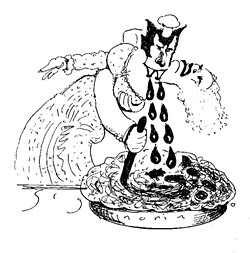
- Slug Signorino
Is it true that due to similar protein compositions, blood can be used as an egg substitute in baking and in ice cream?
—Kathy
Kudos, Kathy. As a result of your question, "Blood Cookie" is no longer just an extremely death-metal name for an album of children's music—it's also something we've actually whipped up in the Straight Dope Test Kitchen.
As a general proposition, of course, cooking with animal blood has been popular across time and geography. Swedes and Finns use it in pancakes. Southeast Asian cuisines avail themselves of all manner of the stuff—pig, chicken, duck. Poles eat duck-blood soup; in east Africa, the Massai people drink cow's blood straight up. The Brits and the Irish enjoy black pudding; the Spanish and French make blood sausages called morcilla and boudin noir, respectively. Getting closer to your question, pig's blood is the thickener of choice in the Italian chocolate pudding sanguinaccio.
In the United States, you'll find animal blood sold and consumed mainly among immigrants of more recent vintage—like at Korean and Thai groceries. It's made some headway, though, in high-end kitchens, probably thanks to the snout-to-tail trend that's rolled through the culinary world in recent decades. Several years ago a Washington, D.C., restaurant called the Pig offered a frozen variation on sanguinaccio billed, inevitably, as "Sundae Bloody Sundae." One critic sniffed that "the novelty was more exciting than the actual dessert," and it seems no longer to be on the menu.
But insofar as the chef at the Pig did make something like chocolate ice cream using blood instead of egg yolks, here we see progress right along the lines you suggest. The Scandinavians are apparently at the forefront of this pursuit; the best source I found on the subject is Nordic Food Lab (NFL)—an adjunct of the Copenhagen restaurant Noma, a mainstay on world's-best lists—which exists as a sort of open-source testing ground for all sorts of outré culinary ideas. In 2014, NFL's Elisabeth Paul published the results of an investigation into the possibility of blood as an egg replacer. Her arguments in favor are strong: Egg intolerance is a major food allergy among European children. Anemia, meanwhile, is everywhere a prominent nutrient deficiency; know what's got a lot of iron in it?
And the chemistry's right. In egg white, six protein types interact to trap air when the white is agitated—say, by whipping. This is the first step in making a meringue, or in more technical terms a colloidal foam: tiny gas bubbles suspended in a liquid. Key in baking, though, is the protein ovalbumin, which coagulates when heated and so prevents collapse. Ovalbumin accounts for about 54 percent of egg-white proteins; conveniently, related albumins make up about 55 percent of the proteins in blood plasma. In theory, then, sure, this ought to work.
What about in practice? Paul reported salutary results after using pig's blood in place of eggs in recipes for sponge cake, meringue and ice cream; she also mixed it with vodka (after straining out a few unwanted clots) into a cocktail dubbed the "Red Russian," which was—per her terse but telling description—"only sipped once." A key finding here was that pairing blood with something acidic, as in a sourdough bread, will go some way toward masking its, er, more assertive flavors.
Unwilling to leave all the glory to the Danes, I called up my local butcher, who rendered unto me twice the volume of cow's blood I'd requested (no pig's was available), and gratis, which tells you something about local sanguinary demand. By the time I got to it the following day, much of it had coagulated into a slimy block. (I hadn't asked, but this can be prevented by the butcher treating the blood with an anticoagulant, such as vinegar.) I whipped some of what was left with sugar; the process took maybe 10 minutes longer than egg whites typically do, but eventually the mixture rose into a lofty and visually striking pink foam. The blood meringues fell in the oven, but that may just mean I should've whipped the stuff at still greater length.
Next I tried the pastry qua non: the chocolate chip cookie, substituting, at the recommendation of NFL, 65 grams of blood per egg; in this case I also made a control batch. The results? The blood cookies came out of the oven about an eighth-inch shorter than the batch with a whole egg in it. This tracks with a 1994 Iowa State University dissertation in which researchers compared egg whites and bovine blood plasma in cake baking, finding that an egg-white cake boasted "slightly larger volume, significantly more crowned profile and finer texture" than the plasma version. But come on: The fact that my cow blood produced a recognizable (and, I should add, edible) dessert at all is what I would call passing with flying colors—specifically, a greenish-gray hue seen in both the meringues and the cookies, which, I'll concede, eaters might be justified in finding off-putting. Perhaps this suggests opportunities for future innovation.
Send questions to Cecil via straightdope.com or write him c/o Chicago Reader, 350 N. Orleans, Chicago 60654